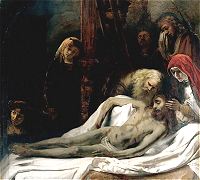 click to enlarge |
LAMENTATION Studio of Rembrandt Van Rijn SN 252, oil on canvas From "The Pages" |
ARTIST:
Rembrandt was painter, etcher, and draftsman…his country’s greatest artist. Born in Leiden, he studied at a Latin school and a few months in University before leaving to study painting. His most influential teacher was Pieter Lastman (c1624), with whom he spent six months in Amsterdam; from him he took not only his predilection for mythologic and religious subjects, but also his manner of treating them with dramatic gestures and expressions, vivid lighting effects, and a meticulous glossy finish. By 1625 he was working as an independent master in Leiden. It was the busiest period of his life, as he quickly established himself as the leading portraitist in the city. The most important work from this time is The Anatomy Lesson of Dr. Tulp, which brought a whole new vitality to the group portrait.
Rembrandt’s success in the 1630s was personal as well. In 1634 he married Saskia van Uylenburch; his tender portraits of her reflect a blissful union, but their happiness was marred by a succession of infant deaths. Of their four children, only Titus (1641-68) lived longer than two months. Saskia herself died in 1642, the year Rembrandt painted his most famous picture, the misnamed Night Watch, the culminating work of the Dutch tradition of civic guard portraits (a genre particularly associated with Frans Hals). In spite of a 19th c story regarding the clients’ dissatisfaction, evidence suggests this picture was well received.
Although portraits and religious works bulk largest in his output, he made highly original contributions to other genres, including still life. And he painted some - such as The Polish Rider – which defy classification.
Nevertheless, in the 1640s Rembrandt’s life did take a downward turn. He concentrated more on religious and landscape pieces, and his style grew more introspective. There were domestic problems, too. Geertge Dircx, a widow employed as nanny to Titus, sued Rembrandt for breach of promise after his affections turned to Hendrickje Stoffels, a servant some 20 years his junior. Unpleasant legal proceedings ended with Geertge’s remand to an asylum. Because of a clause in Saskia’s will, Rembrandt was unable to marry Hendrickje, but they were together the rest of her life, and she bore him two children. ( A daughter, Cornelia, born in 1654, was the only child to outlive him.) Financial difficulties, too, led to the sale of his beautiful home and his collections; in 1660 he moved to a poorer district. Although his final years were saddened by the deaths of both Titus and Hendrickje, Rembrandt continued to be respected, and worked till the end. He faced life with dignity, neither disillusioned nor bitter.
SUBJECT:
The scene is a Deposition. Christ’s body has been removed from the cross (by special permission, because criminals’ bodies were usually left to rot). In the background St John weeps and Mary Magdalene leans against the cross. In the brightly-lit foreground, Christ’s body lies on a white cloth, while the Virgin caresses His head and Joseph of Arimathea supports His arm. Others of Christ’s followers are unidentified.
PAINTING:
This artist was skillfull: the pathos and tenderness of these figures, the balance of youth and age, the contrast of the white sheet with the radiant color of the Virgin’s red cowl attest to that skill. It is derived from an oil sketch by Rembrandt which included many more figures than those in our painting.
Rembrandt had numerous students who came to his studio to study, but unlike Rubens, Rembrandt didn’t design paintings for them to execute. Almost all of his students worked in a style similar to his. Nicholas Maes was one of his students.